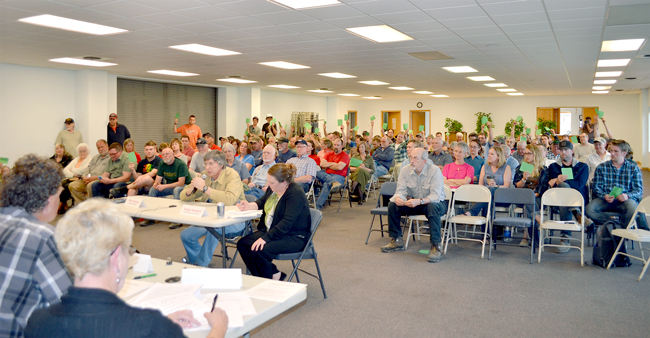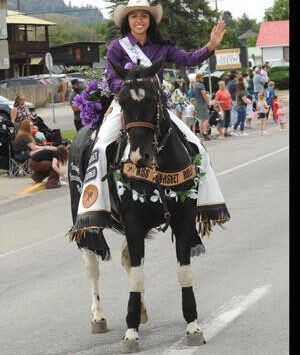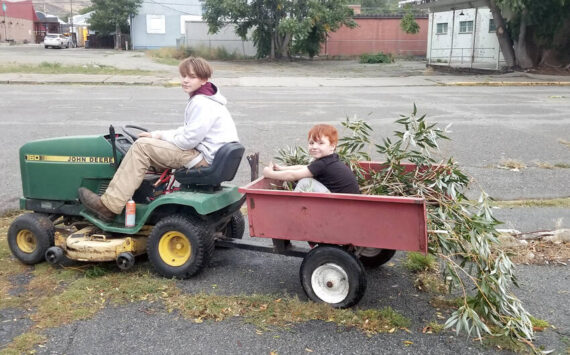
“….after two years of working with us, he’s bought his first house. This is testimony to a lot of the farms and everything they’re bringing to the community.”
Brandon Stevens,
Green Company
OKANOGAN – The Okanogan County Regional Planning Commission met April 11 at the county fairgrounds Agriplex building to allow for continuation of public testimony regarding the revised zoning code and DEIS (draft environmental impact statement).
The first meeting, held March 28, was so well-attended that many people needed to voluntarily delay attendance to avoid the meeting being completely rescheduled.
Over 40 people testified at the March 28 meeting, and another 35 testified April 11.
Okanogan County Planning Director Perry Houston brought commissioners’ public comments emailed in, and said the comments were continuing to stream in.
People both for and against the county’s moratorium on pot production, processing and retail operations within unincorporated Okanogan County addressed the planning commissioners passionately about their fears, frustrations and hopes for the future.
Due to press time restrictions, the following are just some of the first comments made during the April 11 meeting. A more complete representation of community members’ testimony will be in next week’s issue of the Okanogan Valley Gazette-Tribune. Meanwhile, community members are asked to get their comments in to planning commissioners as soon as possible.
Brandon Stevens, Tonasket resident and co-owner of an indoor/outdoor cannabis farm spoke of the “the massive economic benefit that our industry brings to the area.”
“One of our employees has worked at a mill for ten years up in Oroville, and after two years of working with us, he’s bought his first house,” said Stevens. “This is testimony to a lot of the farms and everything they’re bringing to the community. I know there’s a lot of things that we are butting heads on, but we can definitely work together and figure this out without completely eradicating our industry.”
John Herzog handed commissioners paperwork that he described as “copies with a little bit more extended briefs with some attachments and pictures” before paraphrasing his testimony in order to stay under the three-minute time limit of the public meeting.
“Regardless of our pro or con opinion of the legality of cannabis, the issue here tonight is how the county representatives adopt this approach to non-regulation of cannabis growing operations is now impacting the lives and dreams of people,” Herzog stated, adding that the smell and lighting of the industry “ruin any sense of country charm.”

Along with the lack of regulation, Herzog voiced frustration over the location of grow operations in neighborhoods. Herzog claimed tax records of landowners and cannabis support persons had mailing addresses in Kirkland, Lake Stevens and Everett.
“These people declare the profitability and success of cannabis was near $100 million last year, with projections of $150 million this year. Then why did the PUD provide $976,000 for green energy infrastructure if these operations are so successful?” asked Herzog.
Phyllis Laurie said she grew up in Okanogan before joining the Army and then spending the last 20 years working in Humboldt County’s weed industry, “where the economy is so strong there’s thousands of grow operations just around the little town of Gardnerville.”
Laurie said she spends a lot of her money where she makes it, “so I would love to be able to earn it here and spend it here in Okanogan.” Laurie urged community members to “educate themselves” about prohibition by reading the book ‘The Emperor Has No Clothes.’ “It’s a great book about everything concerning marijuana and hemp and how prohibition doesn’t work,” said Laurie.
Jack Dennison, who resides in the North Pine Creek area of Tonasket said his concerns included whether or not marijuana could really affect the employment rate in the county. Dennison also said he felt people needed to be a resident and legal to vote within the county to have a say in “how this county is going to look and operate.” Dennison expressed the desire to have marijuana farms away from people’s homes.
“You know, it drives their property values down,” Dennison said, adding that he doubted he would be able to sell his property now that there was a marijuana farm next to his house.
“Yeah, I grew up knowing that orchards are going to stink, cows are gonna stink, but never knowing that marijuana’s gonna be next to me and stink. Oh, and one last thing. I’m also a fire commissioner up in Tonasket for Fire District 4,” said Dennison. “As a fire commissioner I have some concerns for how I’m gonna deal with a fire within a marijuana operation, you know? My folks aren’t trained for that and obviously most people like myself; for my job I have to pass a drug test. And marijuana’s still an illegal drug when it comes to passing a drug test. So it’s definitely something to keep in mind. Like I said, the fire thing’s a real concern for me.”
“Marijuana is not anything significantly more impactful than a cattle feed lot, a cattle ranching operation, an apple orchard or even a hay field.”
Peter Nansen,
Omak
Angie Bolich, a resident of Tonasket for 38 years, said she could “confidently assure” community members that the “quality of life has depleted in our neighborhood since the arrival of the marijuana operations.”
Bolich said she lives directly in line with a grow operation, and a significantly larger one negatively alters the entire neighborhood within a mile of her home.
“Growing up north of Tonasket I always thought it would be wonderful to live anywhere on Pine Creek. My husband and I have worked one, even sometimes two jobs to earn our way to buying land and building a brand new home to raise our four children on North Pine Creek. It is exhausting to think some care so little for the families and future that they would allow everything that we have done and earned the right way to be taken away from us by those supporting drug use and destruction of our community,” said Bolich, adding that they put their house up for sale when the first pot farm came into their neighborhood.
“We did not have one person actually look at it,” said Bolich. “So now we’re here to fight for our family.”
Bolich stated she felt the county was making the choice to not support “the number of us who are trying to save the children.”
“I just ask that you remember that drugs and money are not more important than our children’s future. I ask that you value our children and their lives that no price can be assigned to. Make a future for them by not making drugs in the neighborhoods acceptable,” said Bolich.
Don Gray, a longtime resident of Tonasket in the Janice Bridge area spoke of past frustrations with nearby businesses such as the smells and dust from a cattle and horse ranch, noise from an orchard blowing cherry cannons and the calcium carbonate RR site causing light and noise pollution.
“Like many residents, I did buy 80 acres to try and keep development away from me, but it really wasn’t enough,” said
Gray, adding that workable solutions were found. “The calcium carbonate place put up a sound barrier and the cannon in the orchard continues, but they give all the residents quite a few cherries. I’m not suggesting that for marijuana, I’m just saying that’s Okanogan County; it’s part of it. If you don’t like agriculture in general, you really shouldn’t live here. It’s just beginning to get going here, and it’s going to be very beneficial to the county, and it can and it will become a good neighbor for everybody.”
Omak resident Peter Nansen said he saw two problems: gentrification over agriculture in Okanogan County, and culture.
“We have a lot of people coming in here who just want to live in a rural environment and enjoy their little patch and figure they kind of own everything between them and the top of Omak Mountain,” said Nansen, adding that he had seen it many times before in other locations. “We have to understand these people come in to Okanogan County and they see a blissful, pastoral environment and they don’t really expect to have someone move in next to them that’s trying to make a living. But we have to remember where the money comes from in this county.”
Nansen said regarding culture, he felt a lot of people “looked down their noses” at people growing cannabis, but “these are just people who are businessmen who aren’t hippies, they’re not drug dealers, they’re just trying to make a living. But really when it comes down to it my main objective I’m stating is marijuana is not anything significantly more impactful than a cattle feed lot, a cattle ranching operation, a mining operation, an apple orchard or even a hay field.” Nansen urged community members and commissioners to start to accept the marijuana business. “There are some things that need to change and I think the lighting issue is an easy one to deal with.”

Bob Tollefson, who has lived on Greenacres Road the last 18 years said a few things concerned him, including the lights and odors of the farm and people who mistakenly turn down his driveway. Tollefson suggested having the lights point to the ground rather than up in the air. “A lot of them, the fencing looks real nice, but there’s others that blow in the wind; there’s gotta be some uniformity there.” Tollefson said he wondered about how much wages the industry actually put in the county. “It would be interesting to see how much they put in L& I. I don’t know what the average wage is that they pay but it’s probably minimum wage.” Tollefson said he was also concerned about deflation of property value.
Additional speakers addressed concerns voiced about property values, safety, environmental conditions including lights and smell, and economic and health benefits to the community. Watch next week’s edition of the Gazette-Tribune for comments from more residents and business owners.
“….after two years of working with us, he’s bought his first house. This is testimony to a lot of the farms and everything they’re bringing to the community.” Brandon Stevens, Green Company






Comments are closed.